
William F. Margold, who passed away in 2017, was a part of the very fabric of the adult entertainment industry, almost from the its beginnings. Actor, director, agent, publicist, historian, staunch defender of free speech and of the the industry and those in it. But before he was any of that Bill Margold was a journalist[1] and a film reviewer, mainly for LA Xpress and other underground newspapers.

By happenstance I came into the possession of a number of LA underground papers from the 1970s, and miracle of miracles several have Bill’s mainstream film reviews in them! So over the course of the next few months we’ll be transcribing and posting Bill’s reviews for your consideration. This first installment comes from the June 15, 1973 edition of SWING (Volume II, Number 29), a weekly swingers rag.
BATTLE FOR THE PLANET OF THE APES
The Very Last Banana
(20th Century-Fox)
Once upon a time there was a planetful of apes. In a period of five years (1968-1973), like the biblical begats, a series of motion pictures about the planet evolved from a studioful of humans.
At first, with “Planet of the Apes”, the series was magnificent and powerful. Faltering briefly with a ridiculous but lavish second installment entitled “Beneath the Planet etc.”, the series leaped to new heights with the third simian visit, “Escape from etc.”
The ending of “Escape” was ready made for another installment but sadly the designers of the series weren’t as prepared. So along cam “Conquest etc.” It was, at best, a weary and cluttered monkey versus man tale. “Well,” I though to myself as “Conquest” concluded with the apes in command, “that’s it for the series.” Not quite! 20th Century-Fox, not content with letting sleeping apes lie, now delivers the fifth ride on the “Monkey-Go-Round.” Entitled “Battle” (you know the rest), it is a ride that I could have missed.
The premise of men in apes outfits aping men, has worn very thin (as have the make-up and costume ideas) by now. The uninspired script by Paul Dehn, who wrote the last three films as well and who must be going bananas, plus very loose direction by J. Lee Thompson (he didn’t aid “Conquest” too well) doesn’t help monkey matters much either.
Roddy McDowall, who has loped through four of the five films, turns in his usual cool and free swinging performances as Caesar (son of Cornelies, hero of “Apes I and II”). Opposing him in this simian squabbles Claude Akins, who never looked or sounded better, as a hostile gorilla.
The rest of the cast is docile, with the exception of gnomish pop singer Paul Williams who livens up things a little as a wise orangutan named Virgil.
The film, and the series, ends with John Huston, as a lawgiver ape, pontificating on all that has transpired in the past. While it is sad to say goodbye to the “Apes” that we have come to know and love, I for one, will be quite happy if I never see them again. Barring an occasional showing on television, of course.
SHOWDOWN
Growing Old Honestly
(Universal)
The most laudable quality about George Seaton’s “Showdown” is that its stars, Dean Martin and Rock Hudson, are getting old and fat, and, they’re not afraid to show it. Of course, the two actors aren’t ready for the sanitarium yet, but their boyhood days are a long time past them.
As a couple of middle age cowboys whose deep friendship is put to the test by social pressures, Dean and Rock are excellent, as well as endearing. The fat that their bellies are edging out over their belts, that they grimace a little when they have to move quickly, and that their eyes look as if they have seen more years than they’d like to admit, makes their characters totally believable, and makes the film a neat little success.
Director Seaton draws history out well, as he utilizes flashbacks to show the buddies growing up and then growing apart.
The age old “one stays good while the other goes bad” motif takes on a warm luster under Seaton’s meticulous handling In fact, the production reflects effort on the part of all involved.
Martin, as the guy on the wrong side of the law, hasn’t been so enjoyable in years. Gone is his usual sleepwalking through a performance. Measuring out just enough mischievousness with common sense, Dean delivers on of his strongest, if not the most complete character portrayal of his career. Only his part of Bama in “Some Came Running” can rank with the fine touches he lends to his role in “Showdown”.
Hudson, as the towering bastion of law and order, brings a sharp, humorous air to his part, proving that given the proper role, he can certainly act rather than just react in motion pictures.
Capable support is lent by the entire cast, from Susan Clark as the woman who had to choose between Rock and dean through John McLiam as a fanatic law abiding citizen.
A collection of competent actors, including Donald Moffat and Ben Zeller, are malevolently proper as Martin’s co-pursuers. While Hudson has to do it because he is the sheriff, Moffat and his motley friends appear to be in it for pure fun.
“Showdown” travels over some of the same ground that a little classic called “Ride The High Country” did about ten years ago. Such a comparison should only be taken as the highest of compliments, and for “Showdown”it is a justly deserved one.
HITLER: THE LAST TEN DAYS
Comic Opera
(Paramount)
Truth may be stranger than fiction but in some cases it is also far less entertaining. Such is the csae of “Hitler: The Last Ten Days.”
OK, OK, we all know that Adolf Hitler was a bad man. But, was it necessary to make a bad film about him just to prove the point?
Director Ennio De Concini has gone beyond normal biasness and shows us such a one-sided, absolutely deranged study of an historical figure, that by the time the film is over, one is almost pulling for Adolf to survive and flee to South America.
As for me, I came not to praise Hitler, but De Concini has most certainly buried him. True, Hitler was, for the most part, a dishonorable man, but even the worst of us deserve some sympathy.
Apparently despite herr dictator, I mean the director, Sir Alex Guiness delivers his starring role, as the man who would have ruled the world, flawlessly and completely. His tyrannical scenes are superlative etchings in the art of acting. The physical resemblance is exceptional, and Sir Alec even makes the most out of his little mustache.
Valiantly, Sir Alec tries to infuse life into a man whom director and screenwriters have designed as terminally evil. The battle takes place in a bunker deep beneath the crumbling Third Reich glory of Berlin.
In a desperately manic and sadly comic game of charts and maps, Hitler becomes The Queen of Hearts from “Alice in Wonderland”, as he orders countless generals and old friends to be replaced or exterminated at will.
Based on fact as much as possible, the film is styled like a grotesque comedy. This ply only hinders, as one starts to balk at the consistent ridiculousness of the man and the lines that were chosen for him to say.
Cluttering up the proceedings even more are a host of superfluous supporting players. Simon Ward, last seen as “Young Winston”, switches sides of the war-fence, and becomes one of the last loyal Nazis. Or at least he’s loyal until he gets to see his idol up close. Neither actor or subplot are strong enough to make Mr Ward an asset to the film.
As a pair of “never say die” Luftwaffe lovers, sexy Diane Cilento and stern Eric Porter are capable, but look strangely uncomfortable.
Doris Kunstmann plays the doughy Eva Braun broadly, but at times appears so clumsy and stupid, that one would think that Hitler would have opted for a mistress who was a little less dense.
One thing De Concini has succeeded in doing is creating an atmosphere of almost total claustrophobia. In fact, outside scenes are jarring and uneven, while inside the bunker, events go on incessantly.
“Hitler: The Last Ten Days” is a celluloid tombstone for a man, who no matter how infamous he was, deserved at least one flower in his memory.
PAT GARRETT AND BILLY THE KID
At Home With Sam
(Metro-Goldwyn-Mayer)
Sam Peckinpah is back home on the range, and I for one, wouldn’t have it any other way. The grizzled director who gave the world “violence”, a special writhing, Blood-soaked, bullet riddles meaning in “The Wild Bunch”, has returned to the scene of his most famous films: the West.
With “Pat Garrett and Billy the Kid”, Sam delivers his most impressive film-epic yet. I enjoyed the “Bunch” more (it’s my favorite film of all time) and will always have a warm spot for his lyrical “Ride the High Country”, but for pure directorial art, I sit in awe of his latest gem.
All of the wily old dog’s tricks are evident in “Pat and Billy”, but thanks (I think) to six editors, the motion picture is a study in numbing excitement.
Wile Sam has a tendency to run off at the trigger (“The Getaway”) and at the mouth (“Straw Dogs”) occasionally, his sextet of film cutters have gleaned his work down to a properly balanced creation of meaningful words and equally meaningful wounds.
Based on the relentless pursuit of the outlaw William Bonney by outlaw-turned-lawman Pat Garret, Sam launches his own relentless pursuit of the viewer’s conscience.
Billy and pat were friends. Neither man is to be totally admired, but both are to be liked. Both men, in a sense, are doing a job. Billy was maintaining a free spirit, while Pat, although envious of Billy’s freedom was trying to “grow old and grey”.
The mutual admiration and their mutual determination that led to the inevitable showdown between these couple of pawns in the massive game of historical progress is Sam’s backyard. And boy, does his garden bear glorious fruition.
Like some semi-moronic and manically homicidal teddy bear, Kris Kristofferson renders Billy as a “who gives a damn” living legend. It is an extremely natural performance.
Dominating the film however is James Coburn. In all honesty, as much as I’ve always liked the lanky actor (ever since he tossed that knife in “The Magnificent Seven”) I never though that he had a really great performance in him. Thanks to Sam though, who seemingly wrenched every ounce of acting ability out of Coburn’s soul, the laconic start turns in a riveting and absolutely believable characterization. It is a role that James Coburn can back off from and radiate in to his dying day. He is Pat Garrett.
Peckinpaw chose singer Bob Dylan to play an idolizing subject to the Kid. It was a wise choice for Dylan not only came to act but he also created the perfect music for the film. His plaintive wailings and moanings strike an eloquent harmony with the beatings of means’ hearts and the spilling of their blood. As each new body joins the long list of Sam’s cinematic casualties, Dylan’s music intensifies until man, music, and movie are one, inseparable.
Equally inseparable are the supporting players from the Who’s Who of Westerns that Sam wisely sprinkles throughout his film. With them, he brings in a bountiful harvest of memorable mini-portrayals and countless poetic scenes.
Such familiar and friendly faces a Richard Jaeckel, Chill Wills, R.G. Armstrong, Luke Askew, Jack Elam, Emilio Fernandez, Paul Fix, L.Q. Jones, Katy Jurado and espcially Slim Pickens, waft in and out of the film with consummate ease. As each performer appears, the viewer nods to himself and thinks, “I know that face, it’s nice to see him again.” Such is the pure genius of Sam Peckenpaw, who appears in his own film briefly, vividly and most appropriately as an angel of death. But, as I’ve said before, Sam is definitely at home on the range.
COFFY
Grounds For A Refund
(American International)
While having absolutely no redeeming value, at least plotwise, the performances from a few of the actors in “Coffy”, make the comic book minded film minimumly bearable. However, one wonders if they are really acting.
Rober DuQui is definitely with it as a supercool pimp named King George, and Booker Bradshaw is dirty but dignified as a corrupt politico.
Having hacked her way through countless jungles and broken out of assorted prisons, Pam “Coffy” Grier now gets caught up in a high class, but very low taste celluloid trap. It’s fitting however, for the pneumatic lady’s talent is starting to sag.
Director Jack Hill leaves no sewer unopened in his relentless pursuit of optimum repulsiveness. The gore and the sex are liberal, and for the most part senseless, as usual, but then how else are poor little Black films supposed to make a living? You see, one watches a film like “Coffy” more out of disbelief than interest. There is a morbid curiosity in seeing just how low a movie can go and still be called “entertainment.”
Mr Hill and his associates haven’t gotten to the movie Mindanao yet, but they sure are sinking fast.
CHARLEY ONE EYE
Laying A Western Omelet
(Paramount)
Take one part Richard (“Shaft”) Roundtree as a deserter from the Union Army. Add one part Roy (“The Invaders” Thinnes as a lame Indian. Blend in one part Nigel Davenport as a foul mouthed bounty hunter. Utilize the old West as a setting. Make it look hot by leaving a gold filter on the camera. Have it sound dirty by having numerous flies drone incessantly. One element is missing, and that’s a pitiful one-eyed rooster who gives the dreadfully concocted film its name.
Under Don Chaffey’s nonexistent direction, rooster and actors mill about for almost two hours. Needless to say, the cock has little to crow about. Charley eventually gets shotgunned to death. Poor rooster. The trio of immobile performers are now reduced to cackling about among themselves. Poor viewer.

Final Note
In a 1975 LA FREEP article[2] Margold said “Having my name in print is one of the great satisfactions in life.” He goes on to say that he’d “like to become a legitimate critic for a non-underground paper.” Based on the sample we have here I’d say that was definitely a missed opportunity.
Notes and things...
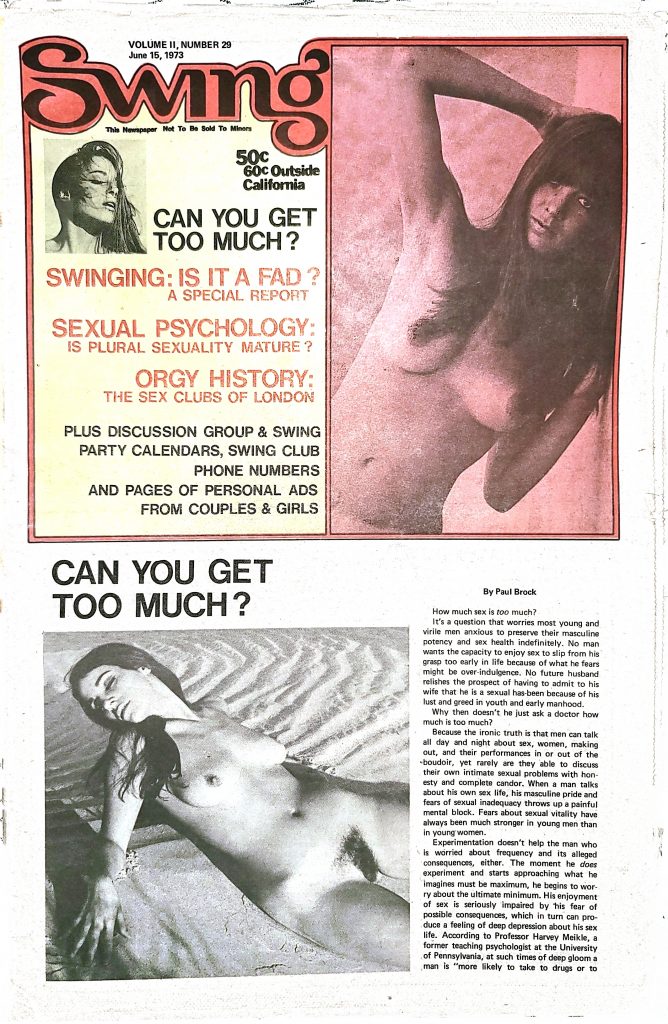
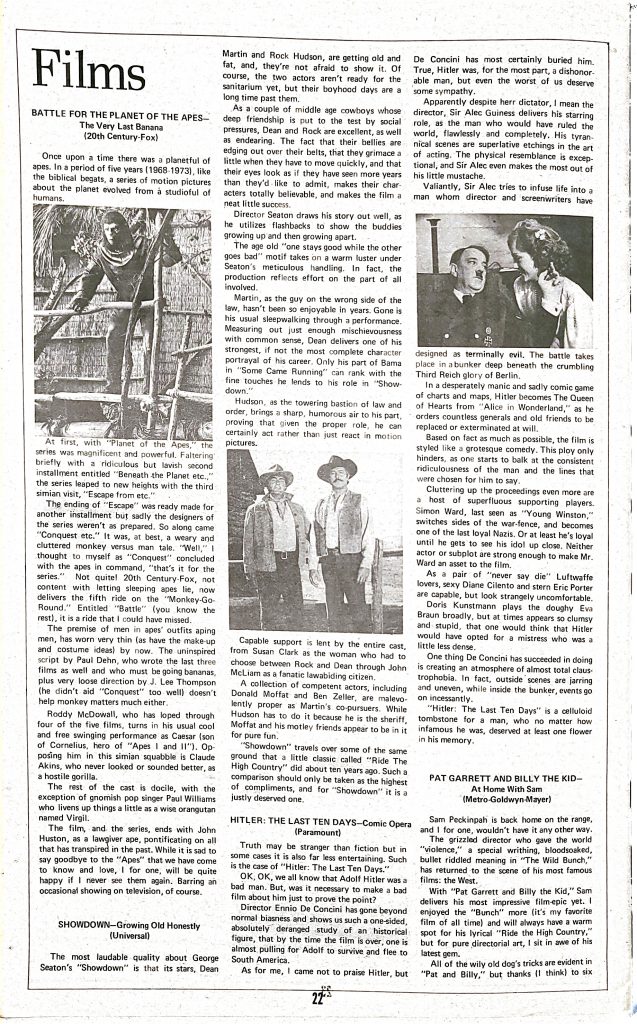
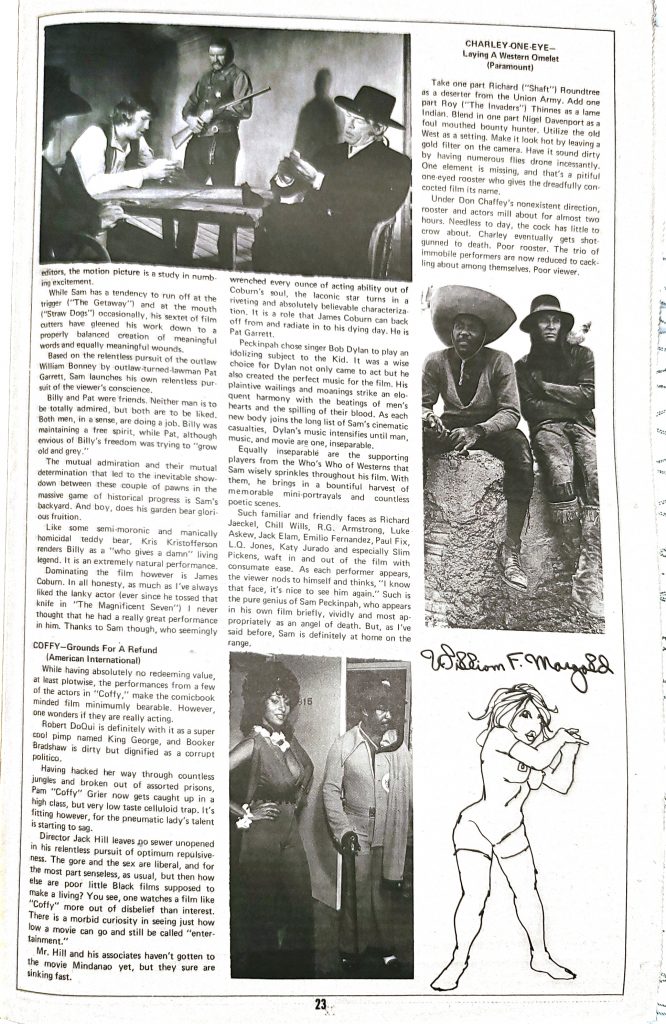
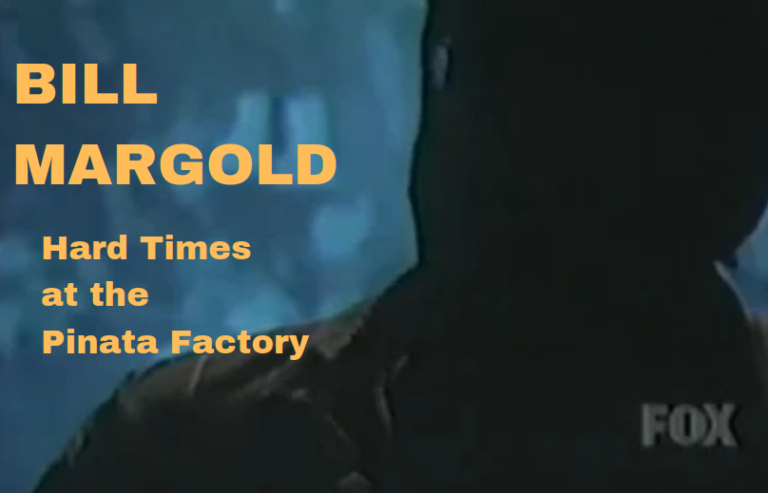
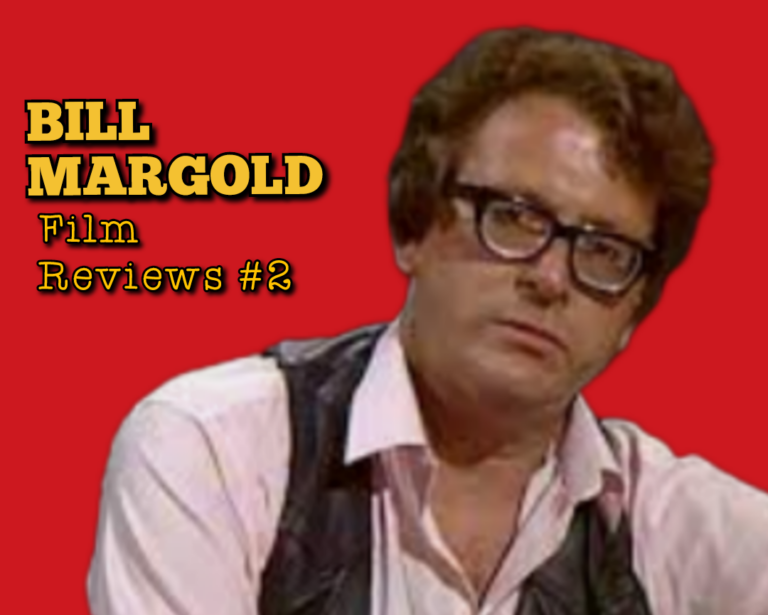
0 Comments